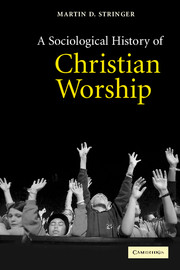Book contents
- Frontmatter
- Contents
- Preface and acknowledgements
- Introduction: Discourse, devotion and embodiment
- 1 Early Christian worship, texts and contexts to ad 300
- 2 Worship and the Christianisation of public space, 300–600
- 3 Hegemonic discourses in the worship of empires, 600–900
- 4 The dominant discourse of cosmological Christianity, 900–1200
- 5 Accessing the demotic discourses of devotion, 1200–1500
- 6 Worship and the rise of humanistic discourses, 1500–1800
- 7 The globalisation of Christian worship, 1800–2000
- Bibliography
- Index
2 - Worship and the Christianisation of public space, 300–600
Published online by Cambridge University Press: 03 December 2009
- Frontmatter
- Contents
- Preface and acknowledgements
- Introduction: Discourse, devotion and embodiment
- 1 Early Christian worship, texts and contexts to ad 300
- 2 Worship and the Christianisation of public space, 300–600
- 3 Hegemonic discourses in the worship of empires, 600–900
- 4 The dominant discourse of cosmological Christianity, 900–1200
- 5 Accessing the demotic discourses of devotion, 1200–1500
- 6 Worship and the rise of humanistic discourses, 1500–1800
- 7 The globalisation of Christian worship, 1800–2000
- Bibliography
- Index
Summary
INTRODUCTION: CHRISTIANISATION
The so-called ‘conversion of Constantine’ in 311 did not mark a sudden shift of a whole society from paganism to Christianity. Many ordinary members of society, both Christian and pagan, would not have noticed any immediate difference. As part of a wider process, however, the relaxation of persecution by the state, and the official encouragement that Constantine gave to certain factions within the emerging church, did mark a significant step in a process that some scholars have come to call the ‘Christianisation’ of the late Roman Empire. This process clearly had its impact on worship as well as on many other areas of social life. At the most basic level, worship in the major centres of the Empire became much more formal, more elaborate and, perhaps most significantly, more public as the fourth century progressed. What is not so clear, however, is whether the increasingly public nature of worship was a consequence of, or one of the many causes of, the wider process of Christianisation. This is what I wish to look at in this chapter.
‘Christianisation’ is the term that some scholars have given to the process that is believed to have taken place across Europe, North Africa and much of the Middle East between the fourth and the seventh century. The use of the term ‘Christianisation’ recognises that while during this period the formal structures of the church grew and by the end of the period the vast majority of the population were at least nominally Christian, the ‘conversion’ of the Empire did not happen in one simple movement.
- Type
- Chapter
- Information
- A Sociological History of Christian Worship , pp. 58 - 88Publisher: Cambridge University PressPrint publication year: 2005



